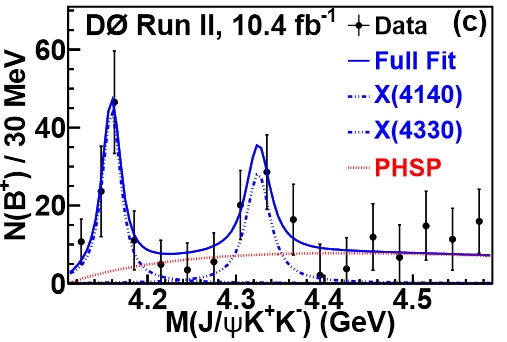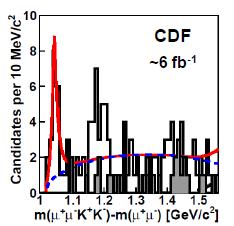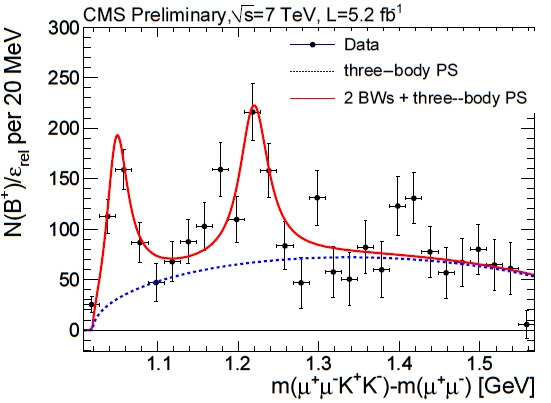Furthermore Belle, a B-factory experiment studying electron-positron collisions, also found no evidence for the Y(4140) state.
With two experiments seeing a signal and two denying it, the situation was controversial. Add to that the fact that the interpretation of these states as simple quark-antiquark mesons is problematic, and that four-quark configurations are proposed as a model, and you get a very interesting picture !
Today, DZERO weighs in with a new analysis that produces a result compatible with CDF and CMS. I believe that, regardless of the statistical significance found for the two states by the various experiments (DZERO sees 3.1 standard deviations for their 4140 MeV state), having three separate experiments observing the same effects is quite strong reason to believe in their reality. Funnily, the two experiments that deny the Y(4140) existence are dedicated B physics facilities - the match between multi-purpose and dedicated experiments is ending 3-0 this time !
Below is the DZERO spectrum of the reconstructed mass of the J/ψ φ system they identify in their full Run II dataset (worth noting is that DZERO calls the state X(4140), ignoring the fact that CDF first found it and named it Y; or rather, acknowledging that they are speaking of the same particle in their introduction, but insisting in calling it X).

As you can see, there is co
 nvincing similarity between the DZERO spectrum and the ones obtained by CDF (with 6/fb of proton-antiproton collisions at 1.96 TeV, see right) and CMS (with 5.1/fb of 7 TeV proton-proton collisions, shown below). Beware - the x axis of these figures shows the mass after subtraction of the (PDG average of) J/ψ mass, but the detail should not confuse you.
nvincing similarity between the DZERO spectrum and the ones obtained by CDF (with 6/fb of proton-antiproton collisions at 1.96 TeV, see right) and CMS (with 5.1/fb of 7 TeV proton-proton collisions, shown below). Beware - the x axis of these figures shows the mass after subtraction of the (PDG average of) J/ψ mass, but the detail should not confuse you.
I believe the matter is settled as regards the existence of these two states; on the other hand, we are still at the very beginning of the investigations of their nature.




Comments